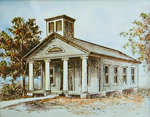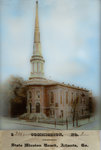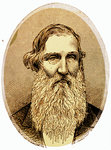


ATLANTA — In 1846 the railroad town of Marthasville, Georgia, was booming. The town, formally called “Terminus,” was no longer a terminus. A rail bridge had been completed over the Chattahoochee River and the Western and Atlantic Railroad was pressing westward. The Executive Committee of the Georgia Baptist Convention decided to take an unprecedented move. For the first time in its 25-year history, a specific location would be targeted for planting a church.
David Gonto Daniell was serving as a state missionary/colporteur under the convention in rural southeast Georgia. Daniell had previously been pastor of the Powelton Baptist Church, where the state convention was organized in 1822. Colporteurs were itinerant evangelists and church planters who preached, sold and/or gave away Bibles and tracts. As requested by the Georgia Baptist Executive Committee, Daniell had relocated to Atlanta by January 1847 where he maintained a small bookstore and continued itinerant preaching in the outlying areas around Atlanta. In Atlanta, Daniell began preaching almost immediately and laying the groundwork for the church.
First Baptist Church was formally organized on Sunday, January 1, 1848, only three days after the city was chartered under its new name, Atlanta. The town’s location at the southern edge of the Appalachian Mountains meant it was becoming the hub of existing and proposed railroads, linking the eastern seaboard with points west. It was a railroading boom town that would keep on booming.
The Georgia Baptist Convention had targeted Atlanta for a new church, and it provided support for its church-planting pastor. The convention began promoting the church by way of The Christian Index and other means available and collecting funds statewide to provide its first building. In June of 1848, the church invited Georgia Baptists, through The Christian Index, to attend the dedication of its new meeting house. This building would continue to be used by the church until after the Civil War when it was used as a field hospital after Sherman’s forces abandoned the city. Although it was heavily damaged during the war it would be repaired and housed the congregation until 1869.
The town continued to grow rapidly and by 1860 had a population of nearly ten thousand. Along with Atlanta, the church continued to grow and became the mother church of other Atlanta churches. Among them were Second Baptist in 1858, Brown’s Memorial in 1887, and Western Heights 1904. During the Civil War, the church ordained Frank (Proctor) Quarles, a slave, to the ministry and established what became Friendship Baptist Church, the first African American congregation in the city. Quarles would become a pivotal leader in the establishment of an African American Baptist Convention in Georgia in 1867, Morehouse and Spellman colleges and fostering cooperation with the Georgia Baptist and Northern Baptist Conventions’ work among the freedmen.
In 1877 the church was able to return the favor after the Convention voted to establish a State Mission Board. This new board was to promote and administer mission offerings, appoint, and supervise State Missionaries. A location was needed to provide office space and the “Mission Room” at FBC was offered. The State Mission Board offices were located at First Baptist Atlanta from 1877-1882. Furthermore, the church has hosted the Georgia Baptist Convention meetings on a number of occasions beginning in 1853.
Many of Atlanta First’s pastors have been leaders in the Georgia and Southern Baptist Conventions. D. G. Daniell (1808-1884) was not only a state missionary, but he was also an agent (fundraiser) for the SBC Foreign Mission Board, a chaplain during the Civil War and an associational missionary. H.C. Hornady (1822-1893) was an editor of the Cherokee Baptist Banner and an agent for Mercer University. Robert Fuller (1824-1880) was an agent for the Atlanta Baptist Orphanage, Mercer University and the associate editor of The Christian Index. E.W. Warren (1820-1893) was the editor of The Christian Index. W.W. Landrum (1853-1926) served on numerous denominational boards and on three occasions turned down offers to be president of institutions. Charles W. Daniel (1874-1951) turned down the offer of becoming executive director of the Georgia Baptist State Mission Board in 1915. Ellis A. Fuller (1891-1950) was president of the Georgia Baptist Convention 1939-1941, leaving FBC Atlanta to become the president of Southern Seminary serving from 1942-1950. James Middleton (1907-2001) was vice president of the Georgia Baptist Convention. Most recently, Charles Stanley (b.1932) served at president of the Southern Baptist Convention from 1984 to 1986. The current pastor, Anthony George, has served on the Truett McConnell board and is currently serving on Criswell College. Virtually all the pastors have served as members of boards and agencies of the Georgia Baptist and Southern Baptist Conventions.
First Baptist Church of Atlanta was established in 1848 because collectively the missionary Baptists of Georgia, identified as the Georgia Baptist Convention, responded to a need, a need based upon loving obedience to the Great Commission. In the 175 years since, as briefly documented above, the church and its leadership have identified and shared with Georgia and Southern Baptists in loving obedience to fulfill the Great Commission through its generosity in mission support, mentoring of missionaries and pastoral leaders in its membership, sharing its leadership with the denomination, and faithfully proclaiming the gospel in Atlanta.
As an example of church planting efforts by the convention, First Baptist would be deemed a success. Missions and cooperation have been a part of its DNA from its inception. The story of First Baptist Atlanta is a reminder of what has and can happen when Baptists collectively and faithfully work together in loving obedience to fulfill the Great Commission.
___
Charles Jones is a Southern Baptist historian, retired pastor, and newspaper columnist.